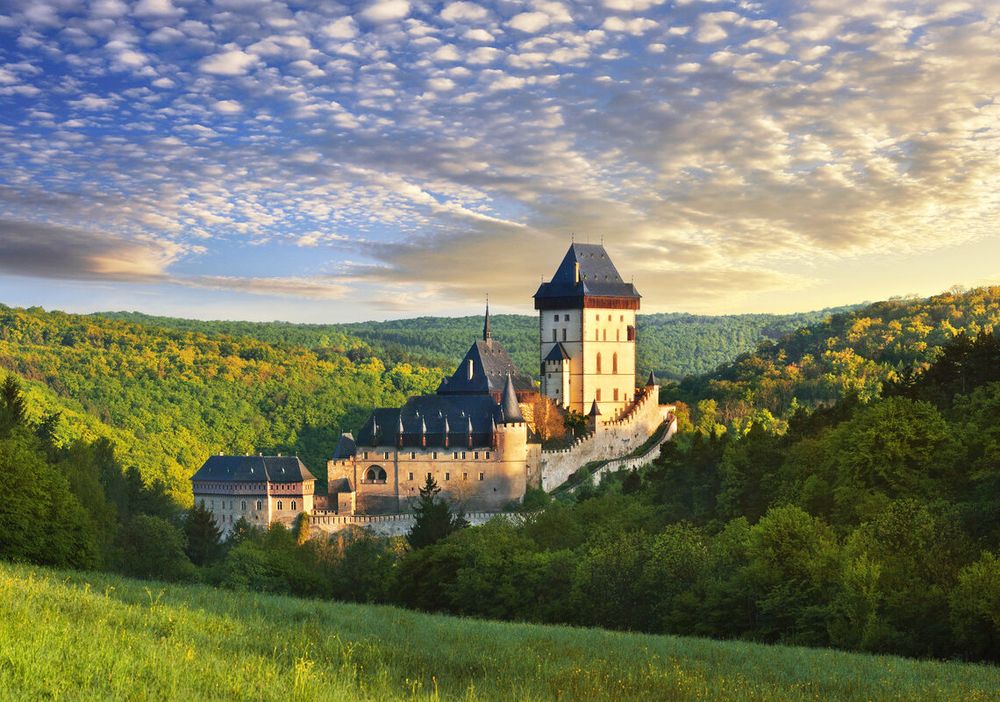Pragueis one of the most exquisite cities in the world. Set above an elbow in the Vltava river, it is a repository of architectural styles from Romanesque and Gothic to Art Deco and even Cubist. Atop a hill is Hradcany, the castle which is home to President Václav Havel, as well as St. Vitus Cathedral. Across the statue-fringed Charles Bridge, the Old Town Square with its medieval Town Hall and Tyn Church is a favorite gathering place. Prague is an arts center with music, theater and galleries.
In Brno, to the southeast, the cathedral’s twin spires dominate the skyline. Lively restaurants and a bustling center make it Moravia’s most important city, ideal for international exhibitions, as well as auto and motorcycle Grand Prix races.
West Bohemia, in the northwest, is very popular due to its world-famous spa towns. The thermal springs of Karlovy Vary (Karlsbad) have made it a retreat especially favored by kings, writers and musicians since the 14th century. The town is also known for its fine porcelain and colorful glassware. Frederic Chopin and Richard Wagner were soothed by the woodland tranquility of MariánskéLázne (Marienbad). Frantiskovy Lázne (Franzesbad) was a favorite of Goethe, and has canary-yellow Baroque buildings. Here also is the city of Plzen, famous for its pilsner Urquell beer and Skoda factory works.
South Bohemiaincludes stops in Ceské Budęjovice and Cesky Krumlov. The first has an arcaded town square; the second, a UNESCO World Heritage site, is a perfectly preserved medieval hill town with castle and gardens. The region has many lakes, châteaux and historical towns, such as Prachatice, Trebon and Tábor. South Bohemia is also renowned for its Budweiser – the original beer of that name.
The mountains of North and East Bohemia are playgrounds for Prague-dwellers. The sandstone formations of Bohemia offer climbers some of the world’s most challenging faces.
South Moravia has thriving farmlands amid valleys dotted with castles. The annual folk festival at Stráznice demonstrates the Moravian love of tradition, music, good wine and plum brandy.
North Moravia’s Beskydy and Jeseniky mountain ranges provide plenty of outdoor activity, followed by unwinding at Jesenik,Luhacovice and other spas.
Attractions
Hradcany, Prague. Part castle (seat of leaders since the 9th century), part church and part gallery high above the city. Includes the National Gallery of Art with greats from Brueghel to Dürer; St. Vitus Cathedral, begun in the 14th century; St. George’s Basilica; and the Collection of Old Bohemian Art.
Josefov, Prague. This former Jewish ghetto has the Old-New Synagogue (the oldest in use in Europe, dating to 1270), a museum of Jewish history and a famous cemetery dating back to the 15th century.
Karlstein Castle. About 20 miles southwest of Prague, this massive castle was originally built to house the coronation jewels.
Kutná Hora. This medieval mining town was, from the 13th to 16th centuries, the economic center of the Czech kingdom. With its Gothic cathedral and fortifications, it is a fine example of urban design of that time. A church in nearbySedleccontains a kostnice (ossuary): a cellar where chandeliers, crucifixes and decorations are made from human bones and skulls.
Sumava mountains. Virgin forests, lofty ridge-top walks, rare vegetation and a pleasant climate combine to make the Sumava range a magnet for nature-lovers. For 40 years, much of the area bordering Germany was closed, leaving nature a free hand.
Telc. A UNESCO World Heritage site, the city’s center still has Gothic ramparts and gates, as well as many Gothic, Renaissance and Baroque houses.
Lednice and Valtice. At the southernmost tip of Moravia is one of Europe’s largest natural parks with lakes, romantic summer residences and lofty castles.
Moravian karst. Just a few miles north of Brno lies an area (39 square miles) of natural wonder, with canyons, valleys, gorges, underground rivers and some 400 caves.
SomethingSpecial
When Emperor Rudolf II (1552Đ 1612) moved his court from Vienna to Prague around 1580, the city prospered as a cultural and political center. An avid patron of the arts, Rudolf’s interests included architecture, science and ethnography. The exhibitionRudolf II and Prague(May 30Đ Sept. 7) will be divided into two parts – The Imperial Court and The Residential City – depicting the life of all social classes. Art works will be shown in sites of Rudolfine architecture, including his Prague Castle residence and Wallenstein Palace. Music, theater and other festivities of the period will be re-created.
